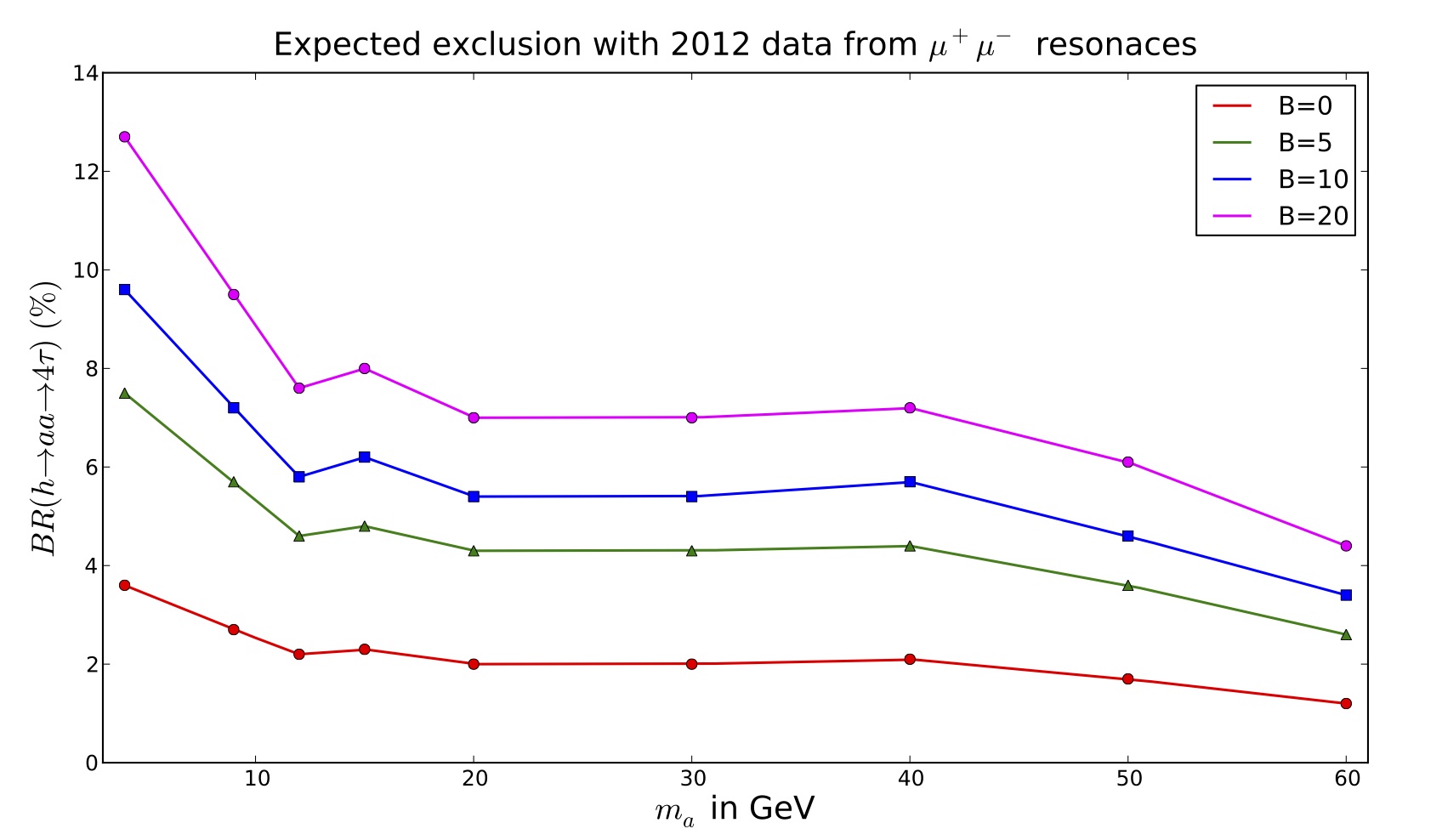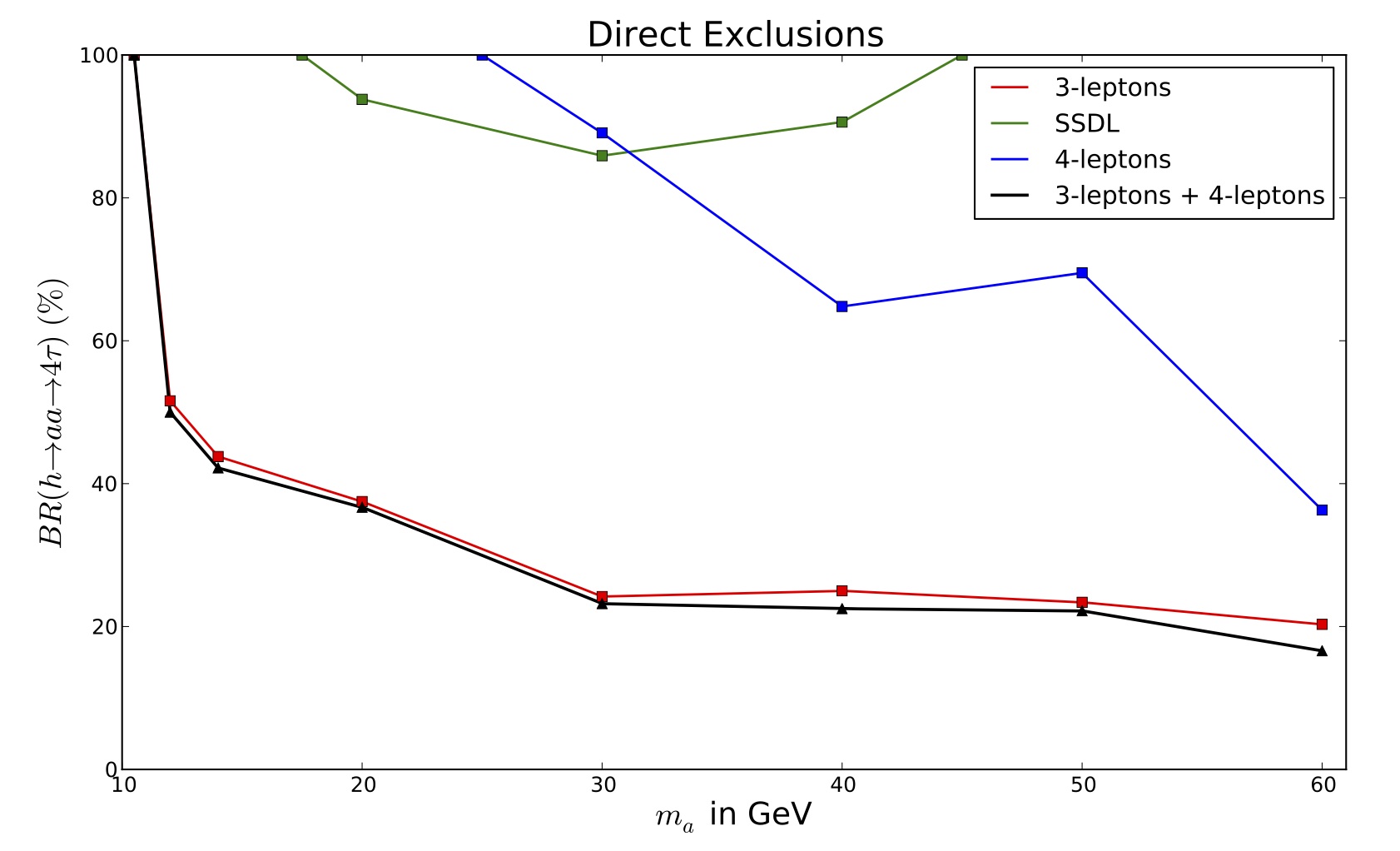Contact Person(s)
Andrey Katz, Zhen Liu, Brock Tweedie, and Rouven Essig More details on this mode may be found in Section 6 of Survey of Exotic Higgs Decays (arXiv:1312.4992).Theoretical Motivation
In this section we consider scenarios where the Higgs can decay into a pair of scalar or pseudoscalar bosons "a," with a mass between 2mτ and mh/2, and with a sizable decay rate to tau pairs. Such a state can arise in 2HDM models supplemented with a singlet scalar field, especially if ma is below the bottomonium region (2HDM+S). A well-known example is the NMSSM with an approximately-conserved R-symmetry, which is a class of Type-II models with a very light pseudo-Goldstone boson. Another simple example is the set of Type-III (lepton specific) 2HDM models with modestly large tanβ, with or without extra singlet fields. There, leptonic decays can dominate for new scalar or pseudoscalar states of almost any mass. Besides focusing on the mass range ma = [2mτ,mh/2], the main assumption that we will employ is that the couplings of a are in direct proportion to the lepton masses. For a above the tau pair threshold, this means that the branching fractions to lepton pairs are in proportion τ+τ−:μ+μ−:e+e− ≅ mτ2:mμ2:me2 ≅1:3.5×10−3:8×10−8. By far the dominant 2→ 4 fully leptonic branching fraction is then 4τ, though there is also a nearly 1% relative Br to 2τ2μ, which contains a tight 2μ resonance [3]. The complications associated with h → 2a → 4τ and the low rates for 2τ2μ means that at present these decays are difficult to constrain, and no significant limits exist from dedicated searches. Nonetheless, the signals are distinct enough that they can ultimately be observed or constrained, even for Br(h → 2a → 4τ) <~10%.Existing Collider Studies
Search proposals at the Tevatron and LHC have exploited the fact that the majority of the 2a decay channels contain one or more leptons. The chance of producing a fully-hadronic final state is only about (0.65)4 = 18%. It has also been pointed out that closeby hadronic taus (or a hadronic tau and an electron) still constitute a jet-like object with unusually low track activity and a distinctive calorimeter pattern, leaving various options for tagging it as a "ditau-jet." Below, we briefly review several recent proposals using a variety of strategies. Note that these all typically assume Br(h→ 2a→ 4τ) ≅ 1 and masses in the range ma ≅ [2mτ,mΥ], so that the a → 2τ decays are highly collimated. Trilepton and collinear eμ: In Ref. [1], the h → 2a → 4τ decay mode is studied in the context of the Tevatron. For ggF, they consider trilepton channels and channels where one of the tau pairs decayed to a roughly collinear eμ pair (to reduce γ* and hadronic decay backgrounds). The collinear eμ case, assumed to recoil against a low-track ditau-jet, could have higher efficiency but also faces higher backgrounds that are much more difficult to model. No attempt is made to estimate these. Most of these ideas can readily be adapted to the LHC. Two μτh-jets: In [2], the 4τ decay is studied for VBF and Wh production at LHC14, exploiting a pair of decays a → μτh(1-prong). For VBF, the events are assumed to be selected with a same-sign dimuon trigger allowing an offline selection of pT > 7 GeV, while the Wh channel is triggered with the leptonic W decay. No search of this type has been performed yet. Dimuon resonance: Ref. [3] considers the subleading decay sequence h → 2a → 2τ2μ, with a focus on identifying the sharp 2μ resonance at ma. The taus are assumed to decay hadronically, and are simply treated as a jet with aligned E/T. This strategy may already be capable of rather stringent limits. D0 has performed a search of this type, which we describe in the next subsection. Ditau-jets: In [4], a calorimeter based "ditau-jet tag" is assessed in the context of Zh → (l+l−)(4τ). (See also [5] for tracker-based techniques tailored to boosted h → 2τ "jets.") For this purpose no lepton identification is used. The main ditau-jet discriminating variables considered are the N-subjettiness ratio τ3/τ1 operating on ECAL cells and the m/pT ratio. (A more powerful likelihood-based tag is also studied.) This would yield only O(1 event) with S/B << 1 with a 2012-like dataset. However, the ditau-jet tag can also be considered for searches in channels with higher cross sections.Existing Experimental Searches & Limits
Dedicated searches for prompt 4τ and 2τ2μ final states of the Higgs have been performed at LEP [6,7] and at the Tevatron [8], respectively, but no significant constraints have yet been established for mh = 125 GeV. No dedicated search has yet been performed at the LHC. We briefly discuss the Tevatron search, and also some non-dedicated searches at the LHC that may have sensitivity to our signal, or can serve as starting points for new dedicated searches. We then recast a subset of the non-dedicated searches to derive new, nontrivial limits. Tevatron 2τ2μ: With 4 fb−1, D0 searched for 2τ2μ (and 4μ) in ggF events [8], based on the strategy presented in [3]. Assuming unit branching fractions for a 125 GeV Higgs, the limit is approximately a factor of 4 above the SM production cross section at the low range of ma, and steadily weakens for larger ma. LHC multilepton analyses:1:- CMS PAS SUS-12-026: 3- and 4-leptons in many exclusive bins, 9.2 fb−1 at 8 TeV [12].
- CMS PAS SUS-13-010: 4-leptons with at least one OSSF pair, 19.5 fb−1 at 8 TeV [13].
- ATLAS 1210.4538: Same-sign dileptons, 4.7 fb−1 at 7 TeV [14].
Proposals for New Searches at the LHC
Looking ahead to possible future searches, we can concretely suggest a novel strategy: exploit the 2τ2μ final-state within 3- and 4-lepton events.2 This would supplement the more inclusive 2τ2μ search proposed in [3] and implemented in [8], representing an analysis channel with extra-low backgrounds. Given the shrinking range of viable Br, and the relatively high rate for the 2τ side of the event to produce a lepton, this type of search should offer good long-term prospects.
References
- [1] P. W. Graham, A. Pierce, and J. G. Wacker, Four Taus at the Tevatron, [hep-ph/0605162].
- [2] A. Belyaev, S. Hesselbach, S. Lehti, S. Moretti, A. Nikitenko, et. al., The Scope of the 4τ Channel in Higgs-strahlung and Vector Boson Fusion for the NMSSM No-Lose Theorem at the LHC, [arXiv:0805.3505].
- [3] M. Lisanti and J. G. Wacker, Discovering the Higgs with Low Mass Muon Pairs, Phys.Rev. D79 (2009) 115006, [arXiv:0903.1377].
- [4] C. Englert, T. S. Roy, and M. Spannowsky, Ditau Jets in Higgs searches, Phys.Rev. D84 (2011) 075026, [arXiv:1106.4545].
- [5] A. Katz, M. Son, and B. Tweedie, Ditau-Jet Tagging and Boosted Higgses from a Multi-TeV Resonance, Phys.Rev. D83 (2011) 114033, [arXiv:1011.4523].
- [6] ALEPH Collaboration, S. Schael et. al., Search for NeutralHiggs Bosons Decaying into Four Taus at LEP2, JHEP 1005 (2010) 049, [arXiv:1003.0705].
- [7] OPAL Collaboration, G. Abbiendi et. al., Search for a Low Mass CP Odd Higgs Boson in e+e− Collisions with the OPAL Detector at LEP2, Eur.Phys.J. C27 (2003) 483-495, [hep-ex/0209068].
- [8] D0 Collaboration, V. Abazov et. al., Search for NMSSM Higgs Bosons in the h → aa → μμ μμ, μμ ττ Channels Using pp Collisions at √s = 1.96 TeV, Phys.Rev.Lett. 103 (2009) 061801, [arXiv:0905.3381].
- [9] CMS Collaboration, S. Chatrchyan et. al., Search for Anomalous Production of Multilepton Events in pp Collisions at √s = 7 TeV, JHEP 1206 (2012) 169, [arXiv:1204.5341].
- [10] ATLAS Collaboration, G. Aad et. al., Search for New Phenomena in Events with Three Charged Leptons at √s = 7 TeV with the ATLAS Detector, Phys.Rev. D87 (2013) 052002, [arXiv:1211.6312].
- [11] CMS Collaboration, Search for RPV Supersymmetry with Three or More Leptons and b-Tags, CMS-PAS-SUS-12-027.
- [12] CMS Collaboration, A Search for Anomalous Production of Events with Three or More Leptons Using 9.2 fb−1 of √s = 8 TeV CMS Data, 2012, CMS-PAS-SUS-12-026.
- [13] CMS Collaboration, Search for RPV SUSY in the Four-Lepton Final State, 2013. CMS-PAS-SUS-13-10.
- [14] ATLAS Collaboration, G. Aad et. al., Search for Anomalous Production of Prompt Like-Sign Lepton Pairs at √s = 7 TeV with the ATLAS Detector, JHEP 1212 (2012) 007, [arXiv:1210.4538].
- [15] S. Kanemura, K. Tsumura, and H. Yokoya, Multi-Tau-Lepton Signatures at the LHC in the Two Higgs Doublet Model, Phys.Rev. D85 (2012) 095001, [arXiv:1111.6089].
Footnotes:
1We do not consider the related but superceded analyses [9,10]. We also do not consider [11], which is very closely related to (1) and uses the same data set, but divides the analysis bins by ST instead of by E/T. This division tends to give lower S/B in the 3-lepton bins. 2A similar strategy was also discussed for associated production of a with a heavy Higgs (via q―q → Z* → Ha) in the lepton-specific 2HDM [15]. That study was aimed at ma,mH \mathrel\rlap ∼ > 100 GeV. 3Note that while isolation of a single lepton from the a→τ+τ− side of the event becomes progressively more difficult for low-mass points, Br(a→μ+μ−) is also increasing. At 4 GeV, the rate has doubled. This effect would be even more pronounced for CP-even scalars.File translated from TEX by TTH, version 4.01. On 10 Dec 2013, 15:59.
